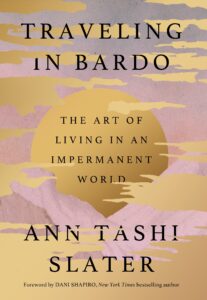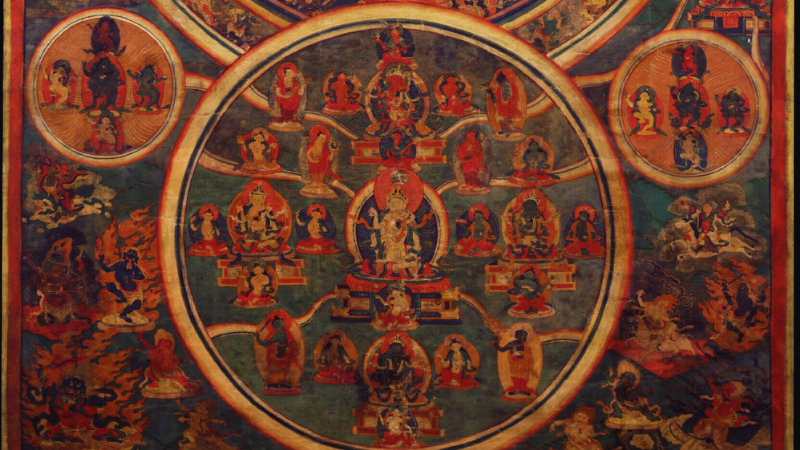On a winter afternoon in 2004, I landed at a tiny airport north of Calcutta and began the sad journey into the Himalayas for my grandmother’s funeral.
Article continues after advertisement
The taxi driver sped up the winding road that I’d first traveled over forty years earlier on my mother’s lap, when I was a small girl and visiting Darjeeling with my parents. Now I gazed out at the familiar tea gardens and villages, the dense forests of bamboo and palms and wild orchids.
Soon the car was enveloped in swirling mist, all coming and going as in dreamtime: a wizened man standing outside a cottage holding a sickle, monkeys scampering by the roadside, prayer flags fluttering over a gorge, four lamas walking single file down a dirt path, their robes vermilion in the gloom.
But now, instead, there would be tea for the people streaming in to pay their respects.
I reached Darjeeling at twilight, as the snowy peaks of Mount Kanchenjunga were vanishing into the blue like great ships setting sail. Along the road, shoppers thronged the market stalls, buying live chickens, vegetables, spices, snacks, and sundries. A barefoot boy hawked bracelets, crying out in a high, singsong voice. As we passed the railway station and made the hairpin turn into my grandmother’s lane, I felt afraid, because for the first time, my grandmother wouldn’t be waiting for me at the door to her little house.
When I had come to see her over the years, I’d always arrived late in the day, and she was ready with cucumber sandwiches and freshly brewed Darjeeling tea.
But now, instead, there would be tea for the people streaming in to pay their respects.
I started up the polished wooden stairs to the second floor, the same stairs my mother used to take two at a time after school, hungry for the momo dumplings and fried flour jalebis my grandmother would put out in the dining room; the stairs that my mother carried me up when I was a little girl; that I climbed when I lived with my grandmother after college and that my own children bounded up when we came for visits.
The same stairs my grandmother’s body would be brought down in a few days, when the death ceremonies were finished and she left her house for the very last time.
My mother had already arrived from her home in California and was on the landing greeting condolence callers. “She was the grand old lady of Darjeeling,” people were saying. “A legend.”
“No one will replace her.”
“It’s the end of an era.”
I walked with my mother along the hall to the altar room, where the prayers for my grandmother were underway. In the glow of butter lamps burning on the old altar carved with the Tibetan lucky symbols, five red-robed lamas sat next to my grandmother’s body, which lay on cushions under a mound of white khada blessing scarves.
In low, incantatory voices, the lamas were reading from The Tibetan Book of the Dead, encouraging my grandmother to move forward without fear in the bardo between death and rebirth.
“Would you like to see your grandmother?” my mother asked in a matter-of-fact voice. Raised as a Buddhist and trained as a physician, she had a pragmatic attitude toward death. She used to tell me and my siblings hair-raising stories about the cadavers she dissected in medical school, or, if she’d been working that day in the ER, about someone impaled on a piece of farm equipment or paralyzed in a motorcycle crash.
I touched her sunken cheeks; her skin felt soft and cold. She was wearing only a thin flannel nightgown—Did she need a blanket?
But not only was I nervous about being so close to a dead body, it also seemed that if I didn’t look, I wouldn’t have to acknowledge that my grandmother was gone. When my mother called me at my home in Tokyo to say that her mother had died, I was stunned, though I shouldn’t have been. Born in 1905, my grandmother was almost a hundred years old—How long did I think she was going to live?
Still, it happened so suddenly. Returning from a trip to see friends in the south of India, she felt her body start to wind down, and soon her kidneys began to fail.
“I’m not sure I can look at her body,” I told my mother, but she was already pulling back the khada scarves.
My grandmother’s thin hair lay in wisps around her forehead and her eye sockets were dark purple. I touched her sunken cheeks; her skin felt soft and cold. She was wearing only a thin flannel nightgown—Did she need a blanket?
I gazed for long moments, certain I’d detect a trace of her, a sign that even a small part of her was still alive. But a terrible sorrow took hold of me as I realized I was only looking at a body, a vessel that had once held my grandmother.
As if hearing my thoughts, my mother told me that when my grandmother died at 1:16 that morning, the lamas were summoned to conduct phowa, a ceremony to transfer the consciousness from the body. It was possible that my grandmother could reach enlightenment through phowa, in which case she would not travel through bardo, but, just to be safe, the prayers from The Tibetan Book of the Dead were being read to help her navigate the after-death journey.
With aunts, uncles, cousins, and other relations, my mother and I listened to the prayers. In the doorway at the back of the altar room that led to the kitchen, the household staff stood watching, bringing hot water for the lamas to drink during breaks. “Instead of tea,” one of the cousins said, “because the lamas are getting health-conscious.”
The sound of hammering came from outside in the driveway, where some men were building a coffin. In the study next to the altar room, the tsipa astrologer lama was casting the death horoscope by consulting the texts he’d laid out on the teak desk where my grandmother used to write in her diary and my grandfather had composed letters to my mother on his Hermes Baby typewriter after she left for America.
Saturday was never an auspicious day for a funeral, and if it was held on Sunday, nine members of the family would die.
The horoscope indicated that the cremation should take place in two days: Friday, December 3, at 9 a.m. “How about Saturday or Sunday?” my mother asked, hoping to give relatives who lived far away time to arrive. The tsipa shook his head. Saturday was never an auspicious day for a funeral, and if it was held on Sunday, nine members of the family would die.
Around seven o’clock that evening, my mother and I left for the Windamere, my grandparents’ Raj-era hotel. The car bumped past the three-story house in the bazaar, where at the turn of the century my grandmother had read Jane Austen by candlelight; up past the colonial-style Planters Club, established for local tea planters in the 1800s; past blue-domed Government House, once the British governor of Bengal’s summer residence; and then to the stone and stucco buildings of the Windamere at the top of town, overlooking Chowrasta, the main square. Farther up, on Observatory Hill, tall cryptomeria trees were silhouetted in the darkening evening, and down in the valleys, lights winked on like reflections of the planets and stars appearing in the sky.
We ate fish curry, okra masala, and English trifle in the hotel’s candlelit dining room, 1920s London jazz playing low and the tables filled with guests from India and around the world. After dinner, my mother adjourned to the bar for a nightcap with her cousins and I went to bed.
As I lay under the wool blankets, listening to dogs bark back and forth in the valleys, I imagined my grandmother setting off in bardo in her black poodle bouclé coat, her headscarf knotted under her chin. She had her usual determined, optimistic expression, and her short, solid figure rocked side to side in the gait I knew well. I saw her going forth in the same fearless way that in 1924, when she was nineteen, she left Darjeeling for Tibet on her pony Graylock (“He ambled so nicely on the precipices”) to join her father in Lhasa, an expedition of hundreds of miles over snowy passes as high as fifteen thousand feet.
Crossing the Tibetan Plateau, my grandmother came upon great caravans miles long, and the muleteers offered her slices of raw yak meat. She encountered French explorer and Buddhist Alexandra David-Néel, the first Western woman to reach Lhasa, traveling down to India.
Now, in bardo, perhaps my grandmother was breaking her journey at a dak bungalow, just as she did on the way to Lhasa. (Dak bungalows, rest houses built by the British, were found in the most far-flung places—surely one existed in the afterworld.)
If only I could go to wherever she was on her bardo journey and bring her back. But even if it were possible to discover her whereabouts, it wouldn’t matter, because she’d know that, just as she’d always told me when people died, the time had come to give up her old body and think about finding a new one.
__________________________________

Excerpted from Traveling in Bardo: The Art of Living in an Impermanent World by Ann Tashi Slater. Copyright © 2025 by Ann Tashi Slater. Reprinted with permission of Balance Publishing, an imprint of Hachette Book Group. All rights reserved.
